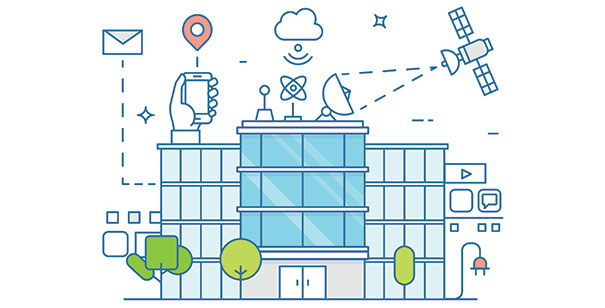The Internet of Things will continue to grow at hospitals as data become easier to share
 |
| ILLUSTRATION BY ISTOCK |
by Jeff Ferenc
It may be tempting to dismiss it as just another buzz phrase in a field bursting at the seams with jargon, but the Internet of Things (IoT) is here to stay in the health care facilities world. And it’s likely to continue to grow in popularity as hospitals leverage technologies in multiple ways to increase efficiency.
In basic terms, IoT gives things from cars to medical devices to building systems the ability to store and share valuable information through the use of data-capturing sensors and radio-frequency identification (RFID).
To varying degrees, many, if not most, hospitals have utilized the IoT for purposes from asset management to controlling temperature and humidity in operating rooms for a number of years. And health care technology and facility experts interviewed for this article expect that the IoT will only expand.
“IoT really is about connectivity, about trying to ensure if there’s a piece of information available to trigger an action, that the action can happen,” says Paul Currie, assistant vice president of enterprise architecture, HCA (Hospital Corporation of America), Nashville, Tenn.
“For instance, I’m thinking about situations in patient rooms where you want a specific temperature if the room is occupied and, if it’s not occupied, that temperature will change. That absolutely is the IoT,” he says.
Another example of how IoT can promote efficiency is a sensor collar for fire extinguishers that remotely detects the condition of a device and whether it needs to be replaced, Currie says. The shared data replace manual checks.
Brendon Buckley, health care technology director, North America, Johnson Controls, Milwaukee, says that the use of sensors leveraging data transmitted from machine to machine has existed for some time in uses such as building automation and environment optimization. “It just wasn’t called IoT,” he notes.
The phrase “Internet of Things” was coined in 1999 in response to a supply chain challenge that was solved through the use of a microchip and a radio receiver that tracked a popular cosmetic product’s inventory status.
Perhaps the highest level of the IoT found in health care today is represented by the Mercy Virtual Care Center, Chesterfield, Mo., says Ted Hood, senior vice president and chief operating officer, GBA, a health care technology consulting firm in Franklin, Tenn.
Opened in 2015, the $50 million virtual care center delivers around-the-clock care through audio, video and data connections by clinical and support staff to remotely monitor patients in four states. Hood expects a growing number of health care systems to incorporate some of the benefits offered by the virtual care center.
IoT expansion poses challenges. Expanded use of data sharing may strain data centers for one.
“As patient monitoring expands to the home and use of wearable devices, clinicians’ monitoring of chronic conditions and incorporation of predictive analytics will increase demands on facility infrastructure and data center requirements,” he says.
The inability of proprietary medical devices to share data with each other will require development of a plug-and-play platform with a standard language. The Center for Medical Interoperability, Nashville, has undertaken that issue as its mission.
Security concerns likely will increase as the level of shared data rises with the growth of IoT. “The volume of data is going to grow substantially along with maintaining security to ensure there are no HIPAA violations or cyberattacks,” Hood says.
As challenges are met and managed, which sources say they are confident will occur in good time, the IoT will create the promise of improved health care.
“All these systems are going to have an incredible impact on care efficiency and without spending a lot of extra money,” according to Andrew Quirk, senior vice president, health care center of excellence, Skanska USA, Nashville. “We just need to be intelligent about how we integrate them.”
Via hfmmagazine.com»
